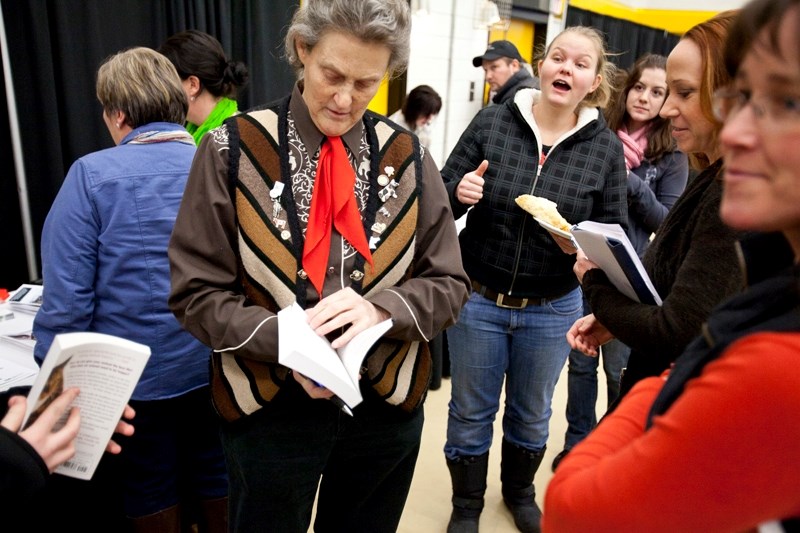Animal Science professor Temple Grandin believes that one of the major issues facing agriculture these days is that the public is getting further and further away from it.ìI think agriculture needs to work on communicating with the public,î Grandin said.ìPut a YouTube video up, showing what you do on the ranch. Open up the doors electronically.îGrandin was in town last Wednesday to give two lectures at a conference organized by Mountain View County and the Foothills Forage and Grazing Association. The extreme cold weather left her unfazed, as she said she experienced similar weather during a past visit in Winnipeg.More than 450 people from all over Alberta braved the cold to listen to her talk about how to keep livestock calm during handling, and facility design.Grandin, who teaches at Colorado Sate University, is a renowned animal behaviour specialist. Drawing from her experience as an autistic person living in a world that often feels strange, threatening and overwhelming, she designs humane livestock-handling equipment and campaigns for better standards in slaughter plants and livestock farms.ìWhen I first started in the industry, I thought I could fix everything with equipment,î she said.ìIf I could just build the right facility, everything would be magically correct.îCattle industryGrandin said that on the whole, the cattle industry's treatment of animals has improved.ìPeople get much better at not causing stress in animals,î she said.ìBut there is a bottom 10 per cent that is really terrible and it is still there.îShe encouraged the attendees to get down in the chute and see what the animals are seeing.ìIf you want to understand animal behaviour, get away from words. What does it look like? What does it feel like?î Grandin said.ìPeople don't notice details. But little details matter. Little details make a difference.îShe also fielded a lot of questions from the audience, which included 160 Olds College students. One student asked Grandin if animals know they are going to die when they are in the slaughterhouse chute.ìThat is a question I had to answer myself when I first started. At the Arizona plant I first worked at, I watched cattle go up the chute,î she said.ìI realized that when I took away things that scared cattle, they would walk right in. I am amazed by how I fixed plants with pieces of cardboard, duct tape, zip ties and portable lights.îGrandin said that if animals knew they were going to die, they would jump back when entering the chute.ìThe Arizona plant has a five-foot, six-inch fence on their main chute,î she said.ìThe cattle could absolutely jump over that fence. But they almost never did.îShe also cautioned the public against making eye contact with cattle.ìCattle, unless they really trust you, view eyes as a threat,î said Grandin.ìDon't stare animals down.îWhen asked at the end of the day what she hoped the attendees would get from listening to her lectures, she said that she wanted people to get a better understanding of animal behaviour.ìAnimals are really into details. They will balk at little things that people tend to not notice: chains hanging down, reflections, and cars going by.ìI want to get people to be more observant.îShe is presently researching how cows protect their calves and the different strategies they use.Grandin invites people interested in her research to go on her website ñ grandin.com ñ which has a selection of her published papers as well as various facility designs.



